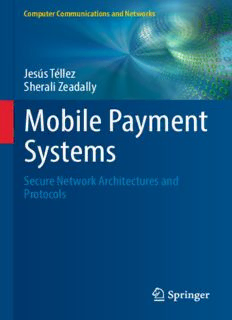
Mobile Payment Systems: Secure Network Architectures and Protocols PDF
Preview Mobile Payment Systems: Secure Network Architectures and Protocols
Computer Communications and Networks Jesús Téllez Sherali Zeadally Mobile Payment Systems Secure Network Architectures and Protocols Computer Communications and Networks Serieseditor A.J.Sammes CentreforForensicComputing CranfieldUniversity,ShrivenhamCampus Swindon,UK The Computer Communications and Networks series is a range of textbooks, monographs and handbooks. It sets out to provide students, researchers, and non-specialists alike with a sure grounding in current knowledge, together with comprehensibleaccesstothelatestdevelopmentsincomputercommunicationsand networking. Emphasis is placed on clear and explanatory styles that support a tutorial approach, so that even the most complex of topics is presented in a lucid and intelligiblemanner. Moreinformationaboutthisseriesathttp://www.springer.com/series/4198 Jesús Téllez • Sherali Zeadally Mobile Payment Systems Secure Network Architectures and Protocols 123 JesúsTéllez SheraliZeadally UniversityofCarabobo UniversityofKentucky Valencia,Carabobo,Venezuela Lexington,KY,USA ISSN1617-7975 ISSN2197-8433 (electronic) ComputerCommunicationsandNetworks ISBN978-3-319-23032-0 ISBN978-3-319-23033-7 (eBook) DOI10.1007/978-3-319-23033-7 LibraryofCongressControlNumber:2017948868 ©SpringerInternationalPublishingAG2017 Thisworkissubjecttocopyright.AllrightsarereservedbythePublisher,whetherthewholeorpartof thematerialisconcerned,specificallytherightsoftranslation,reprinting,reuseofillustrations,recitation, broadcasting,reproductiononmicrofilmsorinanyotherphysicalway,andtransmissionorinformation storageandretrieval,electronicadaptation,computersoftware,orbysimilarordissimilarmethodology nowknownorhereafterdeveloped. Theuseofgeneraldescriptivenames,registerednames,trademarks,servicemarks,etc.inthispublication doesnotimply,evenintheabsenceofaspecificstatement,thatsuchnamesareexemptfromtherelevant protectivelawsandregulationsandthereforefreeforgeneraluse. Thepublisher,theauthorsandtheeditorsaresafetoassumethattheadviceandinformationinthisbook arebelievedtobetrueandaccurateatthedateofpublication.Neitherthepublishernortheauthorsor theeditorsgiveawarranty,expressorimplied,withrespecttothematerialcontainedhereinorforany errorsoromissionsthatmayhavebeenmade.Thepublisherremainsneutralwithregardtojurisdictional claimsinpublishedmapsandinstitutionalaffiliations. Printedonacid-freepaper ThisSpringerimprintispublishedbySpringerNature TheregisteredcompanyisSpringerInternationalPublishingAG Theregisteredcompanyaddressis:Gewerbestrasse11,6330Cham,Switzerland Tothemostimportantpersonsinmylife,my wife,Raiza,andmydaughter,Alexandra, whosesacrificewasessentialtoallowmeto finishthiswork.Ialsodedicatethisbookto myparentswhoarenolongerphysicallyin thisworldbutwillliveinmymindandheart untilmylastbreath.Finally,butnoless important,Icannotforgetmyfriends, brothersandsisters,students,andcoworkers whohavesupportedmeinmyprofessional career. JesúsTéllez Tomywife,Borrara;mydaughters,Zobia andZofia;andmyparents. SheraliZeadally Preface In the last two decades, we have seen significant technological advances in computing, networking, storage, and processing technologies. All these advances have led to the emergence of various types of networks, all kinds of user appli- cations, and a wide range of computing devices whose costs keep decreasing while their performance keeps improving. These new capabilities have paved the way for users to have the ability to access information anywhere, anytime from any personal computing device. Additionally, we have also witnessed the rapid developmentofmobilenetworkingtechnologiesandcommunicationprotocolsthat have accelerated the design and deployment of mobile payment systems (MPSs) whichenablepaymentsforservicesandgoodsfrommobiledevicesusingdifferent methods,suchascreditcardpayments,micro-payments,anddigitalcoins.Security issuesinthesepaymentsystemshavebecomeincreasinglyimportantforallparties involved (customers, merchants, banks, etc.) during their interactions. Security is one of the most important aspects that must be taken into consideration when designing, implementing,anddeploying securepayment systems.Itisessentialto mitigatethreats,vulnerabilities,andrisksthataffectsuchsystems.Whilesupporting securepaymenttransactions,highperformanceisalsoanothermajorobjectivethat must be met by any MPS even in the presence of constraints of portable devices, limitedcommunicationcapabilities,andotherlimitations. The main aim of this book is to present state-of-the-art research achievements and results in the field of MPSs. We expect this book to be a valuable and an authoritative reference for designers, developers, engineers, students, faculty members, and researchers who have a strong interest in mobile commerce and in particularmobilepaymentsystems.Wehaveorganizedthisbookintofivechapters: “(1) Introduction”; (2) “Mobile Device Security”; (3)“Architectures and Models forMobilePaymentSystems”;(4)“SecurityinMobilePaymentSystems”;and(5) “FutureChallengesandOpportunities.” MobilePaymentSystems:SecureNetworkArchitecturesandProtocolsisanin- depthliteraturereviewofrecentresearchresultsobtainedbyexpertsandresearchers around the world, along with the authors’ results in the area of MPSs. We present hereasummaryofthechaptersinthisbook. ix x Preface Chapter1,“Introduction”,presentsthebasicandfundamentalconceptsrelatedto MPSs.Inthischapter,wegiveanoverviewofmobilecommerce,mobilepayment characteristics, existing mobile payment methods, mobile payment stakeholders, and technologies for mobile payments. The chapter further discusses the benefits anddisadvantagesofMPSsandthegeneralentitiesthatunderpinsuchsystems. In Chap.2, “Mobile Device Security”, we review the mobile devices currently available on the market that can perform a variety of tasks. We also discuss the operating systems (OSs) available on the market based on the requirements of mobile devices and the advantages and disadvantages of each OS. We further highlightsomeimportantdifferencesbetweenmobiledevicesecurityandpersonal computer (PC) security to improve our understanding of mobile device security. Thechapteralsopresentsathreatmodel,whichidentifiesthethreatsagainstMPSs, theresourcestobeprotected,thefeaturesoftheattackers,andthepotentialattack vectors. Finally, it highlights two main mechanisms that are used to avoid various kinds of threats for smartphones: intrusion detection systems and trusted mobile- basedsolutions. InChap.3,“ArchitecturesandModelsforMobilePaymentSystems”,wereview the mobile payment models that have been proposed in the literature in the last decade. We classify these models based on the features and technology mostly used by end users. The main goal of this classification is to help readers stay up to date with the state-of-the-art mobile payment models proposed in the literature based on their core features such as micro-payments, cryptographic technique (asymmetric cryptographic and symmetric cryptographic), technology used (short messageservice,biometrictechnology,radio-frequencyidentification(RFID)tech- nology,near-fieldcommunication(NFC),2-Dbarcodetechnology,andpeer-to-peer technology), Session Initiation Protocol (SIP), communication restriction, mobile agenttechnology,andwirelessapplicationprotocol. Chapter 4, “Security in Mobile Payment Systems”, focuses on transaction securitypropertiesthatmustbesatisfiedbyMPSstoensurethatalltheinformation exchanged between the mobile payment user and the entity with which he/she is communicating is secure at all times during the payment transaction made using mobile devices. We present a brief review of the most commonly used cryptographyschemesforsecurecommunicationsamongthepartiesinvolved.This chapter also presents a summary of the types of vulnerabilities and threats and theircorrespondingrisksinanMPSenvironmenttogetherwithrelevantprotection solutions. Furthermore, we discuss some obstacles that make the design of secure MPSsstillamajorchallenge. In Chap.5, “Future Challenges and Opportunities”, we outline some of the challenges posed by MPSs which rely on new emerging technologies that offer attractivebusinessopportunities.Thischapteralsodiscussessecuritychallengesthat mustbeaddressedinordertoestablishasecureenvironmentforubiquitousmobile commerce(m-commerce).Wealsoidentifysomeofthechallengesfacedbyusersin MPSsduetotheirlackofpaymentoptionsaroundtheirmentalmodeldevelopment, usability issues, prepurchase anxiety, trust issues, ease-of-use, and support for routine purchases with mobile payments. We also discuss alternate cryptographic Preface xi schemessuchasellipticcurvecryptographyandself-certifiedpublickeysandtheir applicationstoMPSs.Thischapteralsohighlightsopportunitiesofferedbymobile cloud computing (MCC) and vehicular ad hoc networks (VANETs) in the design anddevelopmentofMPSs. We thank Simon Rees and Wayne Wheeler at the Springer office in London, UnitedKingdom,fortheirconstantencouragement,support,andadvicethroughout thepreparationofthisbook. Valencia,Venezuela JesúsTéllez Lexington,USA SheraliZeadally
Description: